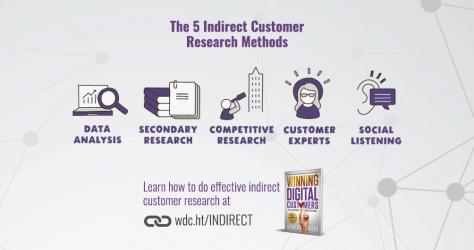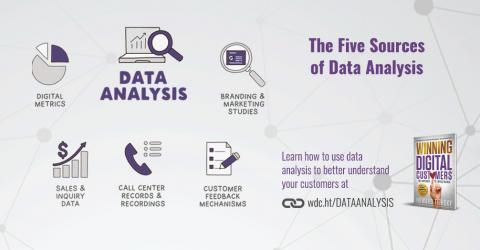This chapter discusses indirect customer research, which is a set of methods used to gain insight into your targeted customers without necessarily interacting with them personally. There is probably already a wealth of customer insight tucked away in various, disparate places within your enterprise, from databases to PDFs to the knowledge in the brains of your customer-facing teams. It can be very fruitful to start aggregating it and analyzing it to understand what it means and how it relates to the research questions that you previously defined. Begin by looking at those research questions and then map them to the different methods described ahead.
Here are the 5 indirect customer research methods:
1. Data Analysis: Data analysis is the process of taking data sources and using them to answer the research questions you’ve defined. Described below are a number of “typical” data sources you may find at a large company.
- Digital Metrics
- Branding & Marketing Studies
- Sales & Inquiry Data
- Call Center Records & Recordings
- Customer Feedback Mechanisms
2. Secondary Research: The term “secondary research” simply means reviewing the research others have already done. There are five primary sources we suggest turning to for secondary research:
- The Internet
- Academic Sources
- Industry Analysts
- Internal Research Project Deliverables
3. Competitive Research: Find out what your competitors are doing. While it may not give you definitive information about your customers, if competitors are doing something that surprises you, there is probably a reason.
4. Customer “Experts”: Customer Experts are people who know a lot about your customers and whose knowledge you can leverage, like the call center representatives in the credit card story at the start of this chapter.
5. Social Listening: If you are an organization of any significant size, customers are talking about you right now on social media. “Social listening software” that’s used to monitor social posts and respond to them for PR and customer service purposes is also very valuable as a research tool.
So that gives you a pretty broad set of tools and places to find information about your customer without even needing to interact with them directly. Through indirect research, you can build a solid profile of the customer. But as we’ve said, it’s most ideally used as the run-up to direct customer research.



